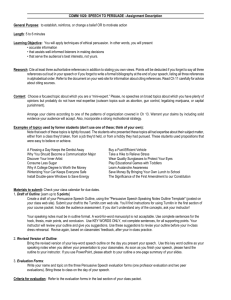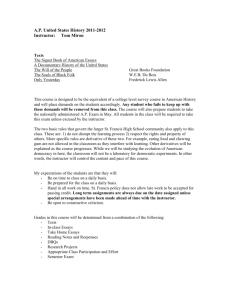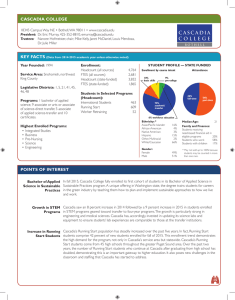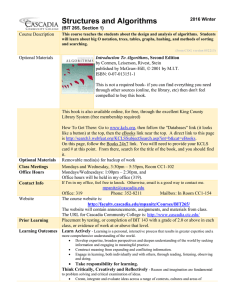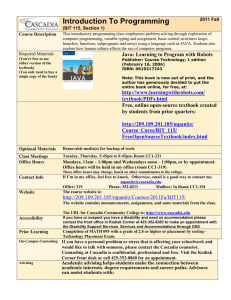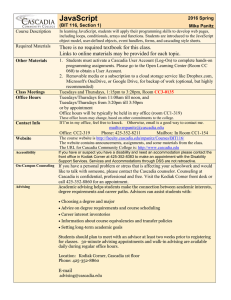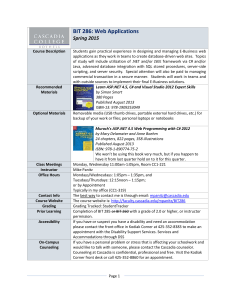Lecture 1 PowerPoint
advertisement
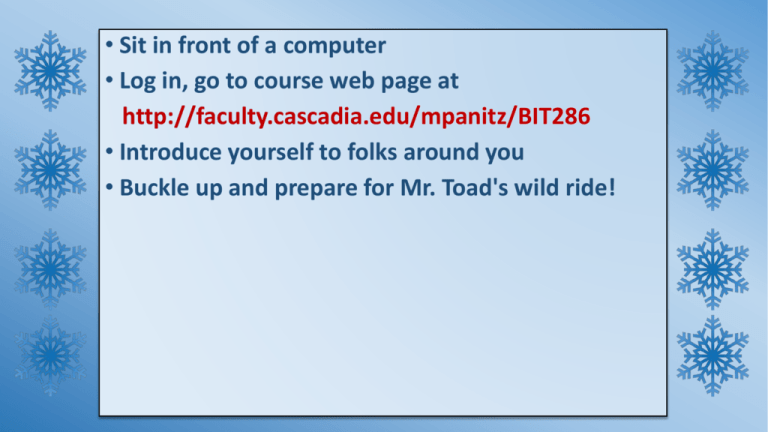
• Sit in front of a computer • Log in, go to course web page at http://faculty.cascadia.edu/mpanitz/BIT286 • Introduce yourself to folks around you • Buckle up and prepare for Mr. Toad's wild ride! BIT 286: (Web) Application Programming Instructor: Mike panitz Lesson 01 Course Orientation; Software Requirement Specifications TODO • Does anyone need any Azure passes (6 months, $100 credit per month, for free)? • If so email me at Mpanitz@Cascadia.edu BIT286: Web Applications Official Web Site: http://faculty.cascadia.edu/mpanitz/BIT286 Classroom: CC1-221 (it’s cozy!) Class Times: Monday/Wednesday 11am - 1:15pm StudentTracker: BIT 286 (for Submissions and Grade Tracking) Instructor: Mike Panitz Instructor Email: MPanitz@cascadia.edu Instructor Office: CC1-319 (top floor, hallway ‘behind’ the elevator) Instructor Office Hours: Mondays/Wednesdays: 1:05pm – 1:35pm, and Tuesdays/Thursdays: 12:15noon – 1:15pm; or by Appointment Recommended Course Textbook Learn ASP.NET 4.5, C# and Visual Studio 2012 Expert Skills with The Smart Method by Simon Smart 24 Chapters, 822 Pages, 358 Illustrations Published August 2013 ISBN: 978-1-890774-75-2 Companion Site: http://aspnetcentral.com/ I’m not 100% sure that we’ll actually use this. Syllabus and Grading Syllabus: Listed on the ‘Home’ tab for the course web page Grading: 1000 Points Total for Quarter Assessments Percentage Points In-Class Exercises, 1 per class session 50% 25 each X 20 classes (3) Milestones 50% 150, 150, 200 100% 1000 Syllabus and Grading • The ‘in class work’ may be handed in a future class • For example, today’s in-class work is due 1 week from today Required Software/Tools • • • • • • • Dreamspark https://www.dreamspark.com/ On the Hub: http://onthehub.com/download/free-software/ Windows (7 or 8) Visual Studio 2010/2012 (Professional/Premium/Ultimate) Microsoft SQL Server (for ICEs) Cascadia VMWare Views (for remote access) Microsoft Azure (6-Month Student account through invite) Instructor Note (1)* The Psychology Of A One-Hit Wonder Teaching BIT2856 is probably a one-shot deal for me this quarter. I'm only teaching because Dr. Brian Bansenauer, who normally teaches this class, is gone Winter Quarter on a limited sabbatical and then will be spending half-a-quarter teaching inNOT TEACHING THE COURSE RIGHT NOW. As such, as I have never taught this class before and won’t teach it until this quarter next year, the earliest. Also, have I mentioned that I’m teaching 4 courses (instead of the normal 3) AND that it’s been a while since I’ve taught BIT 116? This does not mean that I'm going to be giving you a shoddy product—only that this class is going to be more ‘student driven’ than, say BIT 142/143 (which I’ve taught over an over for years, and as a result now have excruciatingly detailed instructions for those classes. I will be counting on each of you more than usual to help me take up the stretches of slack or outright gaps. This means that we're all in the same boat together, and we are all expected to help each other out. So: we must all work together, or risk falling together. Capisce? *The Fine Print The Big Idea This course is being split down the middle: 1)Project management / software engineering (SE) lite In ASP.Net WebForms 2) MVC (ASP.Net MVC, then later Angular.js) • The plan is to alternate between SE and tech lessons • This way you’ll have some time to complete the SE work outside of class • Many of the SE lessons will have in-class work that you’ll need to finish outside of class for the points • The SE lessons will be mostly/all group work – each group can hand in a single copy of the work Building something in ASP.Net Web Forms Sofware Requirements Spec (SRS) Software Design Doc (SDD) Work Breakdown Structure (WBS) Learn MVC ASP.Net MVC (Entity Framework?) Test Plan Implementation + Test Angular.js Do this again using an Agile method Any Questions So Far? Software Engineering / Project Management 1. It’s important to have some systematic approach • Even if it’s the wrong one for your project it can still serve as a starting point for discussing pros/cons & finding a better one • We’re going with an amalgamation of stuff 2. It won’t write the software for you • It’s a process to make sure that you dot your i’s and cross your t’s • It’ll keep you organized while working through the project • But you still need to know which technologies to use, when, why, and how Software Requirements Specification (SRS) • “A software requirements specification (SRS) is a description of a software system to be developed, laying out functional and non-functional requirements, and may include a set of use cases that describe interactions the users will have with the software.” – Wikipedia • “In software engineering (and systems engineering), a functional requirement defines a function of a system and its components. A function is described as a set of inputs, the behavior, and outputs (see also software).” -Wikipedia • “a non-functional requirement is a requirement that specifies criteria that can be used to judge the operation of a system, rather than specific behaviors” -Wikipedia Lecture 01: In-Class Exercise From the menu bar, select Lectures and go to the Lectures 01 bar and select Lecture 01 ICE to begin working on today's in-class exercises.
